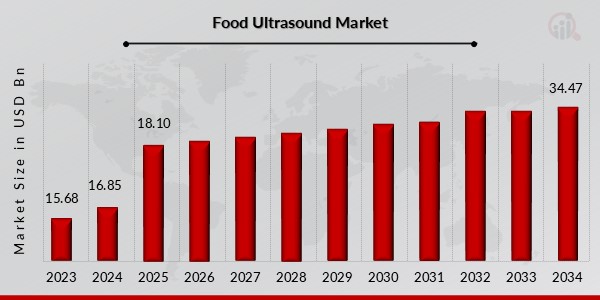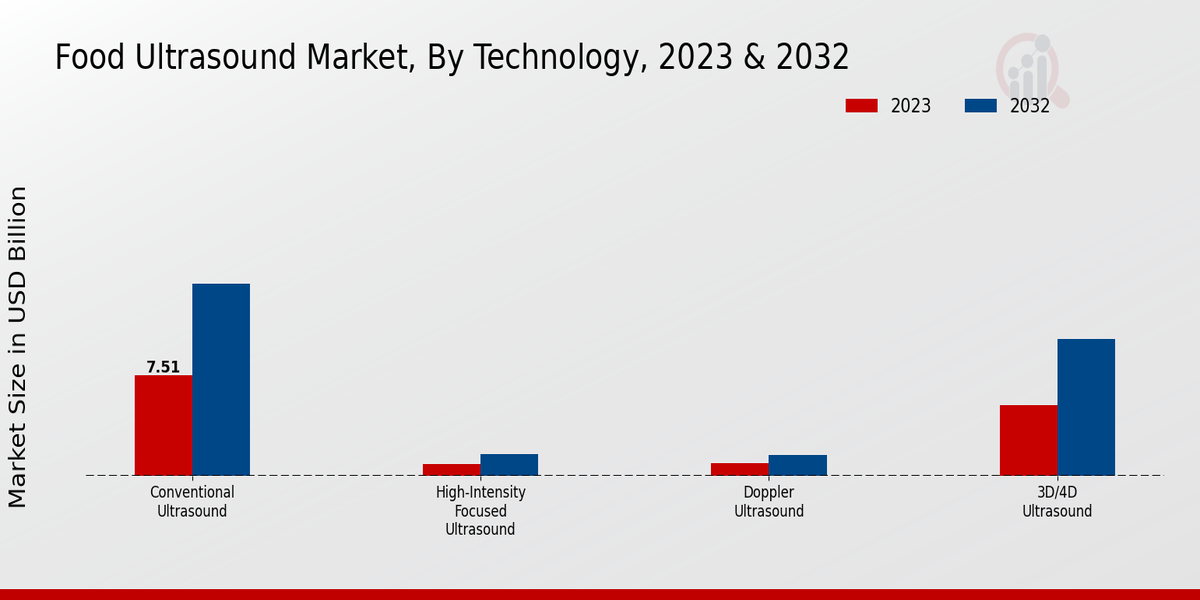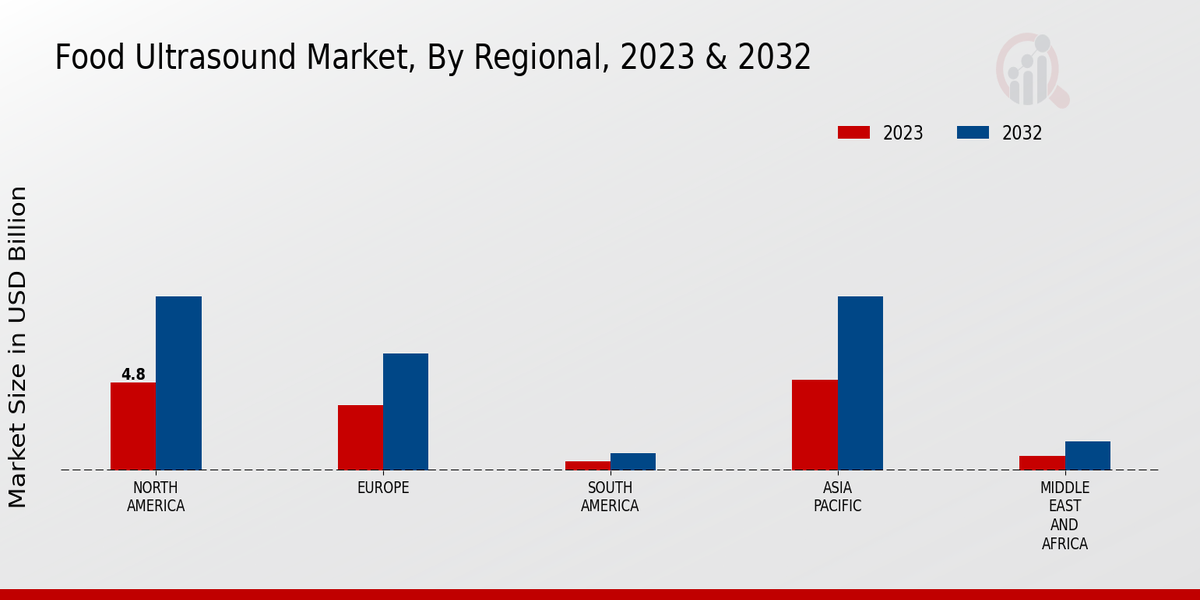Global Food Ultrasound Market Overview
Food Ultrasound Market Size was estimated at 16.84 (USD Billion) in 2024. The Food Ultrasound Industry is expected to grow from 18.10(USD Billion) in 2025 to 34.47 (USD Billion) by 2034. The Food Ultrasound Market CAGR (growth rate) is expected to be around 7.4% during the forecast period (2025-2034).

Source: Primary Research, Secondary Research, MRFR Database and Analyst Review
Key Food Ultrasound Market Trends Highlighted
The Food Ultrasound Market is anticipated to experience substantial growth in the coming years, driven by increasing demand for food safety and quality assurance. Key market drivers include rising concerns over foodborne illnesses, adulteration, and counterfeiting. Ultrasound technology offers a rapid, non-invasive, and cost-effective method for detecting contaminants, evaluating food quality, and assessing food authenticity.
Opportunities for exploration in the food ultrasound market stem from advancements in ultrasound technology. The introduction of high-frequency ultrasound systems and the integration of artificial intelligence (AI) and machine learning (ML) algorithms enhance the accuracy and efficiency of food analysis. These advancements enable food manufacturers to identify and mitigate risks more effectively, ensuring product safety and quality.
Recent trends in the food ultrasound market reveal a growing emphasis on portable and handheld devices. These devices offer greater flexibility and ease of use, facilitating on-site inspections and rapid response to food safety concerns. Additionally, the adoption of cloud-based data management systems allows for real-time data sharing and analysis, improving collaboration among stakeholders in the food supply chain.
Food Ultrasound Market Drivers
Rising Demand for Convenience and Processed Foods
The growing popularity of convenience and processed foods is a major driver of the Food Ultrasound Market Industry. Consumers are increasingly opting for these foods due to their ease of preparation, extended shelf life, and affordability. Ultrasound technology plays a crucial role in ensuring the quality and safety of these products. It is used to detect foreign objects, evaluate product integrity, and monitor the consistency of processed foods.By leveraging ultrasound technology, manufacturers can meet the stringent quality standards required for convenience and processed foods, thereby catering to evolving consumer preferences.
Advancements in Ultrasound Technology
The continuous advancements in ultrasound technology are propelling the growth of the Food Ultrasound Market Industry. Technological innovations have led to the development of more sophisticated and versatile ultrasound equipment, offering enhanced accuracy, precision, and efficiency. These advancements enable manufacturers to conduct more comprehensive and reliable inspections of food products. Moreover, the integration of artificial intelligence (AI) and machine learning (ML) algorithms into ultrasound systems is further enhancing their capabilities.AI-powered ultrasound systems can automate many inspection tasks, reducing the need for manual labor and increasing throughput.
Growing Focus on Food Safety and Quality
One of the key drivers of the Food Ultrasound Market Industry is the rising focus on food safety and quality. Over the last couple of years, this focus has increased, with consumers understanding the importance of consuming safe and high-quality food products. Regulatory bodies and governments are implementing stringent regulations all over the world to ensure food safety and quality. Ultrasound is a non-destructive and highly effective technology that is useful for assessing the internal quality of food.With the use of ultrasound, manufacturers can also detect any contaminants in the food products they manufacture.
Thus, they can meet regulatory requirements and assure consumers of safe and good food.
Food Ultrasound Market Segment Insights
Food Ultrasound Market Technology Insights
The Food Ultrasound Market is segmented into various technologies, including Conventional Ultrasound, High-Intensity Focused Ultrasound (HIFU), Doppler Ultrasound, and 3D/4D Ultrasound. Conventional Ultrasound is the most widely used technology in the food industry. It employs low-frequency sound waves to generate images of food products, allowing for the detection of defects, foreign objects, and other quality issues. High-Intensity Focused Ultrasound (HIFU) utilizes high-frequency sound waves to generate intense heat, which can be used to modify the texture, shelf life, and microbial safety of food products.HIFU is particularly effective in inactivating bacteria and enzymes, extending the shelf life of food products.
Doppler Ultrasound measures the velocity of blood flow in food products, providing valuable information about the freshness and quality of the product. It is commonly used to assess the quality of meat, poultry, and fish. 3D/4D Ultrasound generates three-dimensional or four-dimensional images of food products, providing a comprehensive view of the internal structure and composition. This technology is particularly useful for evaluating the quality of fruits, vegetables, and other food products with complex shapes.The Food Ultrasound Market is expected to witness significant growth in the coming years, driven by increasing demand for food safety, quality, and convenience.
The market is also benefiting from technological advancements, such as the development of portable and handheld ultrasound devices.

Source: Primary Research, Secondary Research, MRFR Database and Analyst Review
Food Ultrasound Market Application Insights
The Food Ultrasound Market is segmented based on application into Abdominal Imaging, Cardiac Imaging, Obstetrics and Gynecology, Urology, Orthopedic Imaging, and others. Among these segments, Abdominal Imaging is expected to hold the largest market share in 2023, owing to the increasing prevalence of liver and abdominal disorders. The Cardiac Imaging segment is also expected to witness significant growth due to the rising incidence of cardiovascular diseases.
The Obstetrics and Gynecology segment is expected to grow rapidly due to the increasing demand for prenatal care and the rising number of pregnant women.The Urology segment is also expected to grow significantly due to the increasing prevalence of urinary tract infections and other urological disorders. The Orthopedic Imaging segment is expected to witness moderate growth due to the rising incidence of musculoskeletal disorders.
Food Ultrasound Market Portability Insights
The Food Ultrasound Market is segmented by portability into portable ultrasound systems and stationary ultrasound systems. Portable ultrasound systems are gaining popularity due to their convenience, portability, and affordability, which makes them ideal for use in remote areas, point-of-care settings, and emergency situations. The Food Ultrasound Market revenue for portable ultrasound systems is projected to grow at a CAGR of 7.2% during the forecast period, reaching USD 1.65 billion by 2024.
The growth of the portable ultrasound systems market is attributed to the increasing demand for minimally invasive procedures, technological advancements, and the rising prevalence of chronic diseases.Stationary ultrasound systems, on the other hand, offer higher image quality and more advanced features, making them suitable for complex diagnostic procedures and surgical applications. The Food Ultrasound Market segmentation for stationary ultrasound systems is expected to grow at a CAGR of 6.5% during the forecast period, reaching USD 2.97 billion by 2024.
The growth of the stationary ultrasound systems market is attributed to the increasing adoption of advanced imaging technologies, such as 3D and 4D ultrasound, and the rising demand for high-quality diagnostic imaging in hospitals and clinics.
Food Ultrasound Market End User Insights
The Food Ultrasound Market Segmentation by End User includes Hospitals, Clinics, Diagnostic Centers, and Veterinary Hospitals. Among these, Hospitals held the largest share of the market in 2023, and is expected to continue to dominate the market throughout the forecast period. The increasing number of hospitals and the growing demand for advanced diagnostic imaging technologies are driving the growth of this segment.
Clinics and Diagnostic Centers are also expected to witness significant growth, owing to the increasing number of outpatient procedures and the rising demand for cost-effective diagnostic imaging services.Veterinary Hospitals are expected to grow at a steady pace, driven by the increasing awareness of animal health and the growing adoption of advanced diagnostic techniques in veterinary medicine.
Food Ultrasound Market Frequency Range Insights
The Food Ultrasound Market segmentation by Frequency Range includes Low-Frequency Ultrasound ( 3 MHz), Mid-Frequency Ultrasound (3-10 MHz), and High-Frequency Ultrasound (> 10 MHz). The Food Ultrasound Market revenue for the Mid-Frequency Ultrasound segment is estimated to reach USD 12.56 billion by 2032, exhibiting a CAGR of 7.8% during the forecast period.
The growth of this segment can be attributed to the increasing adoption of mid-frequency ultrasound technology in various food processing applications, such as meat tenderization, dairy processing, and fruit and vegetable sorting.Low-frequency ultrasound is expected to witness a significant growth rate during the forecast period due to its ability to penetrate deeply into food products, making it suitable for applications such as flaw detection and quality control.
High-frequency ultrasound, on the other hand, is expected to gain traction in the market owing to its ability to provide detailed images of food products, which is essential for quality assessment and research purposes.
Food Ultrasound Market Regional Insights
The regional segmentation of the Food Ultrasound Market presents distinct market dynamics and growth opportunities across key regions. North America holds a significant market share, driven by technological advancements and a growing demand for processed and packaged food products. Europe follows closely, with a mature market and a focus on quality and safety standards. The Asia-Pacific region exhibits high growth potential, fueled by a rising population, urbanization, and increasing disposable income.
South America the Middle East, and Africa regions are expected to witness steady growth, supported by government initiatives and expanding food processing industries.The Food Ultrasound Market revenue is projected to reach 18.45 billion USD by 2024, showcasing the industry's robust growth trajectory.

Source: Primary Research, Secondary Research, MRFR Database and Analyst Review
Food Ultrasound Market Key Players And Competitive Insights
Major players in the Food Ultrasound Market industry are constantly investing in research and development to introduce innovative products and technologies. Leading Food Ultrasound Market players are focusing on expanding their global reach through strategic partnerships and acquisitions. The competitive landscape is expected to remain dynamic, with new entrants and smaller players emerging in the market. Key players are adopting various strategies to gain a competitive edge, such as product differentiation, strategic collaborations, and aggressive marketing campaigns. The Food Ultrasound Market development is influenced by technological advancements, changing consumer preferences, and increasing demand for food safety and quality.
This competitive environment drives innovation and market growth, ultimately benefiting end-users.A leading company in the Food Ultrasound Market, for instance, has a strong global presence and offers a comprehensive range of ultrasound solutions for various food applications. The company invests heavily in research and development to introduce cutting-edge technologies and improve product performance. It focuses on strategic partnerships and acquisitions to expand its market reach and strengthen its position.
The company's commitment to quality and customer satisfaction has earned it a reputation for reliability and innovation within the Food Ultrasound Market.A competitor company known for its advanced ultrasound technology focuses on providing customized solutions to meet specific industry requirements. It has a strong presence in emerging markets and is actively expanding its global footprint. The company invests in research and development to develop innovative technologies and applications for food safety and quality control. Its commitment to sustainability and environmental responsibility has also contributed to its positive brand image.
By leveraging its technological expertise and customer-centric approach, the company has established a strong position in the Food Ultrasound Market.
Key Companies in the Food Ultrasound Market Include
- Mettler Toledo International
- Yokogawa Electric Corporation
Food Ultrasound Market Industry Developments
-
Q2 2025: Ultrasound Market Impacted by Regional Headwinds In June 2025, EU member states voted to restrict access for Chinese vendors to public procurement contracts exceeding €5 million for five years, a move expected to significantly reshape competitive dynamics in the European ultrasound market, including food ultrasound applications.
Food Ultrasound Market Segmentation Insights
-
Food Ultrasound Market Technology Outlook
- High-Intensity Focused Ultrasound (HIFU)
-
Food Ultrasound Market Application Outlook
- Obstetrics and Gynecology
-
Food Ultrasound Market Portability Outlook
- Portable Ultrasound Systems
- Stationary Ultrasound Systems
-
Food Ultrasound Market End User Outlook
-
Food Ultrasound Market Frequency Range Outlook
- Low-Frequency Ultrasound ( 3 MHz)
- Mid-Frequency Ultrasound (3-10 MHz)
- High-Frequency Ultrasound (> 10 MHz)
| Report Attribute/Metric |
Details |
| Market Size 2024 |
16.85(USD Billion) |
| Market Size 2025 |
18.10(USD Billion) |
| Market Size 2034 |
34.47(USD Billion) |
| Compound Annual Growth Rate (CAGR) |
7.4% (2025 - 2034) |
| Report Coverage |
Revenue Forecast, Competitive Landscape, Growth Factors, and Trends |
| Base Year |
2023 |
| Market Forecast Period |
2025 - 2034 |
| Historical Data |
2019 - 2022 |
| Market Forecast Units |
USD Billion |
| Key Companies Profiled |
Hitachi HighTechnologies, Agilent Technologies, Azbil Corporation, Siemens, Yokogawa Electric, Olympus Corporation, Mettler Toledo International, Endress+Hauser, GE, Shimadzu Corporation, Yokogawa Electric Corporation, Thermo Fisher Scientific, ABB, Danaher, Emerson |
| Segments Covered |
Technology, Application, Portability, End User, Frequency Range, Regional |
| Key Market Opportunities |
Growing demand for food safety Increasing automation in food processing Rising awareness of food adulteration Technological advancements in ultrasound equipment Expansion of the global food industry |
| Key Market Dynamics |
Rising demand for food safety Technological advancements Increasing awareness of the benefits of ultrasound technology Growing adoption of ultrasound in the food industry Expanding applications in food processing and packaging |
| Countries Covered |
North America, Europe, APAC, South America, MEA |
Frequently Asked Questions (FAQ):
The Food Ultrasound Market is expected to reach a valuation of USD 34.46 Billion by 2034, exhibiting a CAGR of 7.4% during the forecast period (2025-2034).
North America is anticipated to remain the dominant region in the Food Ultrasound Market, owing to the increasing demand for food safety and quality, as well as the presence of major market players in the region.
Food Ultrasound Technology finds applications in various segments of the food industry, including food processing, quality control, and food safety. It is employed for tasks such as food inspection, texture analysis, and the detection of foreign objects and contaminants.
Key players in the Food Ultrasound Market include Sonoco Products Company, GE Healthcare, and Hitachi, Ltd. These companies are investing in research and development to enhance their product offerings and expand their market presence.
The growing demand for food safety and quality, coupled with the increasing awareness of the benefits of ultrasound technology in food processing, are the primary factors driving the growth of the Food Ultrasound Market.
The high cost of equipment and the lack of skilled professionals in the field are some of the challenges faced by the Food Ultrasound Market.
Advancements in technology, such as the development of portable and handheld ultrasound devices, are expected to shape the future of the Food Ultrasound Market. Additionally, the integration of IoT and AI technologies is anticipated to enhance the efficiency and accuracy of food ultrasound systems.
The COVID-19 pandemic has had a positive impact on the Food Ultrasound Market. The increased focus on food safety and hygiene during the pandemic has led to a greater demand for food ultrasound technology.
Emerging markets, such as those in Asia-Pacific, present significant growth opportunities for the Food Ultrasound Market. The growing middle class in these regions is driving the demand for processed and packaged food products, which require ultrasound technology for quality control and safety.
Regulatory bodies around the world have established guidelines for the use of ultrasound technology in food processing. These regulations ensure the safety and effectiveness of ultrasound systems used in the food industry.
















